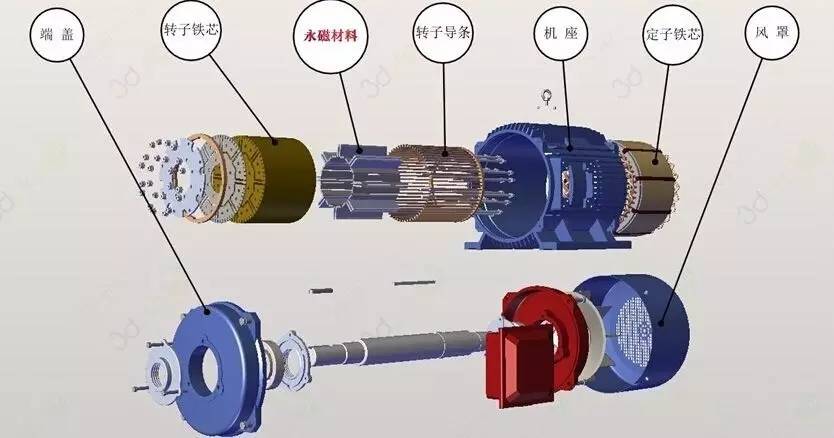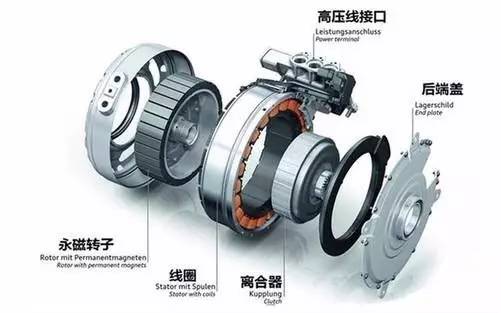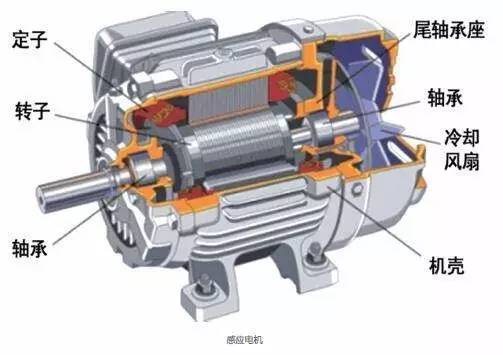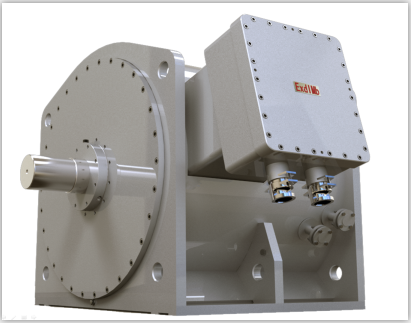20
2018
-
08
What are the advantages and disadvantages of permanent magnet synchronous motors, and what are the developments?
分类:
Industry News
Compared with traditional induction motors, permanent magnet synchronous motors have unique performance. Mainly introduce the characteristics of permanent magnet synchronous motors, and analyze the research status and development trends at home and abroad.
Introduction
The operating principle of the permanent magnet synchronous motor is the same as that of the electric excitation synchronous motor, but it replaces the excitation winding excitation of the latter with the magnetic flux provided by the permanent magnet, which makes the motor structure simpler. In recent years, the improvement of the performance of permanent magnet materials and the advancement of power electronics technology have promoted the development of new principles and new structures of permanent magnet synchronous motors, and have strongly promoted the development of motor product technology, varieties and functions. Some permanent magnet synchronous motors A series of products have been formed, and their capacity has increased from small to large, and has reached the megawatt level at present, and the application range is becoming wider and wider; its status is becoming more and more important, from military to civilian use, from special to general rapidly expanding, not only in micro and special motors It has an advantage in China, and it also shows strong vitality in the electric propulsion system.

1. Features
Permanent magnet synchronous motor uses permanent magnet excitation, which has the unparalleled advantages of electric excitation motor.
1) High efficiency:After the permanent magnet material is embedded in the rotor, the rotor and the stator magnetic field operate synchronously during normal operation, the rotor winding does not induce current, there is no rotor resistance and hysteresis loss, and the efficiency of the motor is improved.
2) High power factor:There is no induced current excitation in the rotor of the permanent magnet synchronous motor, and the stator winding presents a resistive load. The power factor of the motor is close to 1, which reduces the stator current and improves the efficiency of the motor. At the same time, the improvement of the power factor improves the quality factor of the power grid, reduces the loss of power transmission and transformation lines, and reduces the power transmission and transformation capacity, saving power grid investment.
3) Large starting torque:In equipment that requires large starting torque (such as oil pumping motors), a smaller capacity permanent magnet motor can be used instead of a larger capacity Y series motor. If the 37 kw permanent magnet synchronous motor replaces the 45kW ~ 55 kW Y series motor, the phenomenon of "big horse-drawn trolley" can be better solved, the equipment investment cost is saved, and the operating efficiency of the system is improved.
4) Good energy index:When the Y series motor works under 60% load, the efficiency drops by 15%, the power factor drops by 30%, and the performance index drops by 40%; while the efficiency and power factor of the permanent magnet synchronous motor drop very little, when the motor has only 20% load At that time, its performance index is still more than 80% of full load.
5) Low temperature rise:There is no resistance loss in the rotor winding and almost no reactive current in the stator winding, so the temperature rise of the motor is low.
6) Small size, light weight, less consumables:The volume, weight, and materials used for a permanent magnet synchronous motor of the same capacity can be reduced by about 30%.
7) It can be made into air gap, which is convenient to form a new type of magnetic circuit.
8) The armature response is small and the anti-overload ability is strong.
2. Development status
The development of permanent magnet synchronous motors is closely related to the development of permanent magnet materials. The emergence of new permanent magnet materials has greatly promoted the development of permanent magnet synchronous motors. In the 1980s, neodymium iron boron rare earth permanent magnet materials came out. Due to the rich resources of neodymium, cheap iron was used to replace expensive cobalt, and the price was relatively low. NdFeB rare earth permanent magnet materials have good magnetic properties, which greatly promotes the development of permanent magnet synchronous motors.
2.1 Development results
my country attaches great importance to the research and development of NdFeB permanent magnet motors, and has been included in the national "863" research plan. After years of research and development, fruitful results have been achieved. 5 types of high-performance permanent magnet synchronous motor prototypes with 22 typical specifications have been developed.
1) Three typical specifications of high-efficiency, high-starting torque permanent magnet synchronous motor prototypes have successfully resolved the contradictions of high starting torque, good energy-saving effect, high temperature non-demagnetization and reasonable cost. Table 1 shows the performance comparison between 37 kW rare earth permanent magnet synchronous motors and induction motors developed for oilfield pumping units in my country. Table 2 shows the performance comparison of the 1120 kW rare earth permanent magnet synchronous motor with the induction motor and the electrically excited synchronous motor which is newly developed in my country for fan and pump operations.
2) High efficiency and high pull-in synchronous NdFeB permanent magnet synchronous motors (6 specifications) for chemical fiber machinery. Compared with the existing motor, the power factor, efficiency and maximum torque multiple of the developed motor have been improved to varying degrees. The out-of-step torque is 3.59 times the original and the pulling torque is increased by 3 times.
3) 7.5 kW high constant power speed ratio neodymium iron boron permanent magnet synchronous motor and drive system for machine tool spindle. The speed control range of the developed permanent magnet synchronous motor speed control system is 0.4 r/ra in ~9 000 r/min (the speed control range of the domestic spindle induction motor of the same specification is only 8 r/min ~8 000 r/ r e_in), the constant power speed regulation ratio reaches 1:6.
4) Permanent magnet synchronous motors and drive systems for electric vehicles. The developed 7.5 kW permanent magnet synchronous motor system for light electric passenger cars has a motor weight of 45 kg, a magnet consumption of 0.92 kg, a rated speed of 3 000 r/min, and a maximum speed of 5 500 r/min. The overall rated efficiency of the prototype system is 89.1%, the continuous torque density of 1 h is 0.74 N ·m /kg (air-cooled), and the continuous torque density of 15 min is 1.123 N ·m /kg (Japan A The continuous torque density of the ISIMAW prototype for 1 h is 0.78 N ·m/kg) (oil cooling), and the 15 min continuous torque density is 1.178 N ·m/kg.
5) High starting capacity NdFeB permanent magnet starter motor (4 specifications prototype). The developed motor replaces part of the original permanent magnet poles with cheap soft iron auxiliary poles, saving about 30% of neodymium iron boron permanent magnet materials.

2.2 There are problems
In the process of developing high-performance permanent magnet synchronous motors, while the above results have been achieved, some problems have also been obtained, which need to be further studied and explored.
1) Irreversible demagnetization problem. If the design or use is improper, the permanent magnet synchronous motor is at too high (neodymium iron boron permanent magnet) or too low (ferrite permanent magnet) temperature, under the action of armature reaction generated by impulse current, or under severe mechanical vibration Sometimes, irreversible demagnetization, or loss of magnetization, may occur, which will reduce the performance of the motor or even make it unusable.
Therefore, it is necessary not only to research and develop methods and devices suitable for checking the thermal stability of permanent magnet materials used by motor manufacturers, but also to analyze the anti-demagnetization ability of various structural types, so as to adopt corresponding measures to ensure permanent magnetism during design and manufacturing. The magnetic synchronous motor does not lose magnetism.
2) Cost issues. Ferrite permanent magnet synchronous motors are widely used due to their simple structure and reduced quality, and their total cost is generally lower than that of electrically excited motors. Because the current price of rare earth permanent magnets is still relatively expensive, the cost of rare earth permanent magnet motors is generally higher than that of electrically excited motors, which needs to be compensated by its high performance and savings in operating costs. In the design, it is necessary to compare performance and price according to specific use occasions and requirements, and to carry out structural process innovation and design optimization to reduce costs.
3) Control problems. The permanent magnet synchronous motor can maintain its magnetic field without external energy, but this also makes it extremely difficult to adjust and control its magnetic field from the outside. However, with the development of power electronic devices such as MOSFETs and IGBTs and control technologies, most permanent magnet synchronous motors can be used without magnetic field control but only armature control. It is necessary to combine the three new technologies of permanent magnet materials, power electronic devices and microcomputer control in the design, so that the permanent magnet synchronous motor can operate under brand-new operating conditions. In addition, the permanent magnet AC servo system with permanent magnet synchronous motor as the actuator, because the permanent magnet synchronous motor itself is a system with certain non-linearity, strong coupling and time-varying nature, and its servo object also has strong uncertainty. In addition, the system is susceptible to different degrees of interference during operation. Therefore, advanced control strategies and advanced control system implementation methods (such as DSP-based control) are adopted to improve the overall intelligence and digital level of the system. This should be the current A major breakthrough in the development of high-performance permanent magnet synchronous motor servo systems.

3. Development trend
Permanent magnet synchronous motors are gradually being widely used in industrial production and daily life with a series of advantages such as high efficiency, large specific power, simple structure, and significant energy saving effect. Especially in recent years, the successful development of neodymium iron boron permanent magnets with high heat resistance and high magnetic properties and the further development and improvement of power electronic components. The research and development of rare earth permanent magnet synchronous motors has entered a new era at home and abroad. There will be a qualitative leap in both theoretical research and application fields, and it is currently developing towards ultra-high speed, high torque, high power, miniaturization, and high functionality.
3.1 Ultra-high-speed motor
The permanent magnet synchronous motor does not need an excitation winding, the structure is relatively simple, the magnetic field part has no heat source, no cooling device, the coercive force of the material is high, and the air gap length can be larger, which makes it possible to greatly increase the speed. At present, (2 ~ 3) X 10 r/rain motors have been manufactured, such as the 150 kW, 23,000 r/min radial air gap rotor structure developed by General Electric Company, the rare earth permanent magnet generator for aviation. The rotor type is used for 7.2 kW, 27,000 r/rain motors for electric vehicles. Motors with hundreds of thousands of revolutions per minute are currently being developed.
3.2 High torque and high power motor
The successful development of heat-resistant and high-magnetic NdFeB permanent magnet materials will enable them to find important applications in high-power permanent magnet synchronous motors. In the transportation industry and industry, such as electric vehicles, hybrid (combined internal combustion engine and electric motor) power vehicles, trains, elevators, machine tools, robots, etc., the demand for high-power motors is increasing.
Ship propulsion motors require low speed and high torque. In 1986, the German Siemens company developed a 1 095 kW, 230 r/ra in six-phase permanent magnet synchronous motor for the propulsion of ships. Compared with the DC motor used in the past, the volume can be reduced by about 60%, and the loss can be reduced. Reduce by about 20%. In addition, a 1 760 kW permanent magnet synchronous propulsion motor is installed in U. The length and effective volume of the 212 submarine was reduced by 40% compared with traditional DC propulsion motors. The Swiss company A BB has built more than 300 electric propulsion ships with a maximum installed capacity of 2 X 19 MW. Its 400 kW to 3 MW permanent magnet synchronous motors are used in: "Com-paet A~ipod" pod type Electric propulsion system. Compared with the DC motor, the 400 kW, 500 r/ra in permanent magnet motor prototype developed by France Remont Industries in 1987 has also reduced the volume by 40%. In 1996, the 12-phase, 1 800 kW, 180 r/ra in permanent magnet propulsion motor and control device have been developed and all actual ship tests have been completed. In the same year, Britain exhibited a design model of the "HNA" light stealth frigate. The ship is equipped with two 21MW permanent magnet synchronous motors to directly drive the propellers during cruise or stealth.
3.3 Miniaturization
Due to the high maximum energy product of NdFeB permanent magnets, especially ultra-thin permanent magnets can be made, so that ultra-miniature and low-inertia motors that were difficult to manufacture in the past can be realized. At present, ultra-small motors with a diameter of several millimeters or less have been developed to be used as driving sources for medical micro machines, robotic arms for eye surgery, or robots for pipeline inspection. The smallest permanent magnet motor in the world with an outer diameter of 0.8 m m and a length of 1.2 m ln has been manufactured.
3.4 High-functionality
It is difficult to use traditional motors in special occasions such as high temperature, high vacuum or small space, while rare earth permanent magnet motors can withstand high temperatures (referring to samarium cobalt or high heat resistance NdFeB magnets), and are small in size, which can meet these special requirements. . Motors operating in special environments such as manipulators in aerospace equipment, inspection robots for atomic energy equipment, and semiconductor manufacturing equipment require high-temperature motors and high-vacuum motors. Three-phase four-pole permanent magnet motors with a diameter of 105mm and a length of 145mm have been developed that operate at a high temperature of 200oC to 300oC and a vacuum of 133.3 X 10 Pa, with a diameter of 105mm and a length of 145mm. Sm with good high temperature characteristics 2Co permanent magnet.
4. Conclusion
In the 21st century, the rapid development of science and technology, the continuous emergence of high and new technology, and the increasing awareness of power saving and environmental protection have made the future of the development of permanent magnet synchronous motors bright, especially high-performance rare earth permanent magnet synchronous motors and their servo systems. With rapid development and maturity, structural styles will become increasingly diversified, and will also win a wider space for development and gain wider applications.
This article is transferred from Air Compressor Network
More company information
Welcome to pay attention to [Jingji Technology Co., Ltd.] WeChat public account


相关新闻
聚势·谋远·赢未来 | 精基科技2023年度总结暨2024年营销中心工作计划会议顺利召开
2024-03-06

